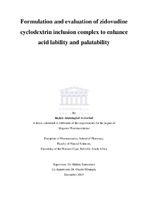Formulation and evaluation of zidovudine cyclodextrin inclusion complex to enhance acid lability and palatability
Abstract
Background: Zidovudine (AZT) is a very useful drug for the management of Human
Immunodeficiency Virus (HIV) infection. Its optimal use is limited by its bitter taste, sparing solubility (20.1 mg/ml) and acid lability. Cyclodextrins (CD) are a class of compounds which can be used to form inclusion complexes with drugs such as AZT to improve it is taste, solubility and palatability. Purpose: This study complexed hydroxypropyl-beta-cyclodextrin (HPβCD) with AZT. The formulated inclusion complex was evaluated for suitability as a dosage form and as a tool for improving AZT’s palatability, solubility and acid liability. Method: AZT was complexed with HPβCD using the lyophilisation method. The binding constant for the formulation was determined by the phase solubility method, and complex formation between AZT and HPβCD evaluated using proton nuclear magnetic resonance (1H NMR), differential scanning calorimetry (DSC), thermogravimetric analysis (TGA) and hot stage microscopy (HSM). Tablets of the inclusion complex were formulated by direct compression, using the least possible amount of excipients, and the dosage form evaluated for hardness, friability, durability, disintegration time and dissolution. Results: The binding constant of the formulation was 3.919, and the degree of incorporation was 4.0 mg AZT/g of CD per complex. 1H NMR showed significant chemical shifts between the inclusion complex and AZT. DSC and TGA analyses showed significant differences in the curves for the pure AZT and HPβCD. Values for tablet hardness, friability, durability and disintegration time were 236 ± 20 N, 0.7 %, 1.02 % and 10.25 minutes, respectively. The solubility of the formulation was 148.08 mg/ml, and its dissolution profile was different from that of the branded formulation. Conclusions: AZT-HPβCD inclusion complex, with a 7.4-fold increase in AZT solubility, was successfully prepared using the lyophilisation method. The binding constant and friability of the formulation were within acceptable limits. Although the hardness value is high, the tablet still disintegrated within acceptable specified times. This study has significant implications for anti-retroviral complex formulations.

